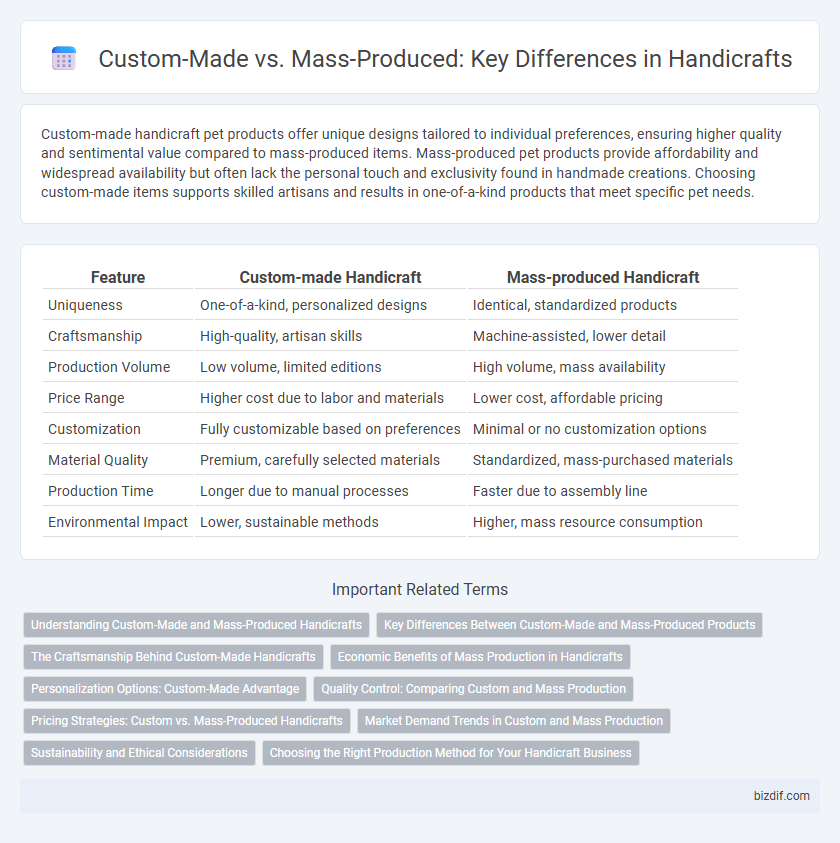Custom-made handicraft pet products offer unique designs tailored to individual preferences, ensuring higher quality and sentimental value compared to mass-produced items. Mass-produced pet products provide affordability and widespread availability but often lack the personal touch and exclusivity found in handmade creations. Choosing custom-made items supports skilled artisans and results in one-of-a-kind products that meet specific pet needs.
Table of Comparison
| Feature | Custom-made Handicraft | Mass-produced Handicraft |
|---|---|---|
| Uniqueness | One-of-a-kind, personalized designs | Identical, standardized products |
| Craftsmanship | High-quality, artisan skills | Machine-assisted, lower detail |
| Production Volume | Low volume, limited editions | High volume, mass availability |
| Price Range | Higher cost due to labor and materials | Lower cost, affordable pricing |
| Customization | Fully customizable based on preferences | Minimal or no customization options |
| Material Quality | Premium, carefully selected materials | Standardized, mass-purchased materials |
| Production Time | Longer due to manual processes | Faster due to assembly line |
| Environmental Impact | Lower, sustainable methods | Higher, mass resource consumption |
Understanding Custom-Made and Mass-Produced Handicrafts
Custom-made handicrafts are unique creations tailored to individual specifications, often showcasing intricate craftsmanship and personalized design elements. Mass-produced handicrafts, in contrast, are manufactured in large quantities using standardized processes to ensure uniformity and affordability. Understanding these distinctions helps consumers appreciate the artistry and exclusivity of custom pieces versus the accessibility and consistency of mass-produced items.
Key Differences Between Custom-Made and Mass-Produced Products
Custom-made handicrafts offer unique, personalized designs tailored to individual preferences, showcasing artisan skill and attention to detail. Mass-produced products emphasize uniformity, cost-efficiency, and rapid manufacturing processes, often sacrificing uniqueness and intricate craftsmanship. The key differences lie in customization level, production scale, and the degree of artistry involved.
The Craftsmanship Behind Custom-Made Handicrafts
Custom-made handicrafts showcase unparalleled craftsmanship, reflecting artisans' meticulous attention to detail and mastery of traditional techniques. Each piece is uniquely crafted, embodying cultural heritage and personalized artistry that mass-produced items cannot replicate. The dedication and skill invested in custom handicrafts ensure superior quality, durability, and aesthetic value.
Economic Benefits of Mass Production in Handicrafts
Mass production in handicrafts significantly lowers unit costs by utilizing economies of scale and standardized processes, enabling businesses to offer more competitive prices. This approach increases output and market reach, driving higher sales volumes and generating steady revenue streams. Manufacturers benefit from streamlined supply chains and reduced labor expenses, enhancing overall profitability in the handicraft industry.
Personalization Options: Custom-Made Advantage
Custom-made handicrafts offer unparalleled personalization options by allowing customers to tailor designs, materials, and dimensions to their specific preferences, resulting in unique, one-of-a-kind items. Unlike mass-produced products that rely on standardized templates, custom-made pieces reflect individual creativity and cultural significance, enhancing their sentimental and aesthetic value. This bespoke approach not only supports artisan craftsmanship but also fosters a deeper emotional connection between the user and the product.
Quality Control: Comparing Custom and Mass Production
Custom-made handicrafts undergo rigorous quality control at every stage, ensuring each piece meets specific standards and client preferences, resulting in superior durability and uniqueness. Mass-produced items rely on automated inspections and standardized processes, which may allow occasional defects due to high-volume output and less individualized attention. Quality control in custom manufacturing enhances craftsmanship precision, whereas mass production prioritizes speed over meticulous detail.
Pricing Strategies: Custom vs. Mass-Produced Handicrafts
Custom-made handicrafts often command premium pricing due to their uniqueness, intricate craftsmanship, and limited production scale, which increase material and labor costs. In contrast, mass-produced items benefit from economies of scale, allowing lower per-unit costs and more competitive pricing strategies aimed at volume sales. Pricing strategies for handicrafts must balance perceived value, production costs, and target market expectations to maximize profitability.
Market Demand Trends in Custom and Mass Production
Market demand trends reveal a growing consumer preference for custom-made handicrafts, driven by increasing appreciation for uniqueness, craftsmanship, and sustainability. While mass-produced items dominate due to affordability and fast availability, niche markets for personalized, artisanal goods are expanding rapidly in global handicraft sectors. This shift influences production strategies as businesses balance scalability with customization to meet diverse customer expectations.
Sustainability and Ethical Considerations
Custom-made handicrafts prioritize sustainability by minimizing waste and using eco-friendly materials, contrasting with mass-produced items that often rely on resource-intensive processes. Ethical considerations in custom-made products include fair labor practices and supporting local artisans, whereas mass production can involve exploitative labor conditions and lack of transparency. Choosing custom-made handicrafts supports environmental stewardship and ethical consumerism, fostering a more responsible supply chain.
Choosing the Right Production Method for Your Handicraft Business
Custom-made handicrafts offer unique, personalized products that cater to niche markets, enhancing brand identity and allowing premium pricing. Mass-produced items enable scalability and cost efficiency through standardized processes, meeting high demand and broad customer bases. Selecting the right production method depends on your target audience, business goals, and resources, balancing exclusivity against volume to maximize profitability and market reach.
Custom-made vs Mass-produced Infographic

 bizdif.com
bizdif.com